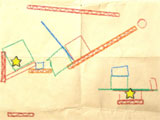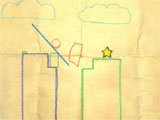|
Petri Purho’s Crayon Physics, like the previously-reviewed Pluto Strikes Back, was created as part of his ongoing Kloonigames experimental game project. Purho tries to put out a new game each month, allowing himself no more than seven days to create each. Crayon Physics was done in five. As a bare-bones prototype, it doesn’t quite have the depth of a finished title. It compensates for a lack of polish with a layer of kindergarten charm and a loop of soothing licensed music. As a proof of concept, the game plays fine. So what’s the concept? Drawing Physical ObjectsEach of the game’s drawing paper screens contains one or more bouncing yellow stars and a small ball of red crayon wax. The puzzle is solved when the ball has touched each of the stars. Obstacles and contraptions - walls, see-saws, bottomless pits - are sketched onto the path in bright, primary crayon colors. But the player can draw too. Anything the player scrawls with the mouse on the drawing paper screen is instantly imbued with weight and volume. Draw a box in the sky and it plummets to the ground. Draw one over a see-saw, and it sends what’s on the other end into the air. A well-placed block will flip the ball over the see-saw and to its destination. Solve physical problems by drawing objects into existence: that’s the premise of Purho’s prototype. You Can Draw Anything You Want, as Long as it’s SquareUnfortunately, Purho’s five-day coding exercise just isn’t as robust as my imagination. Though I’m given this big canvas to draw on, I’m only allowed to sketch squares. Anything I draw, no matter what it looks like, will have the properties of a rectangle when brought to life by the game. A drawing that’s too far off the mark will simply be transformed into a perfect rectangle. It’s often unclear exactly what the dimensions of a new object will be, especially when trying to draw something long and thin. The game would be much more interesting if it allowed me to draw a round ball and a slope to roll it down, but curves are beyond the game’s shape recognition. And while I can play with see-saws the game provides, sketching my own is out of the question. The ball just doesn’t have enough vertical motion - it doesn’t bounce - to do anything but bump the side of anything I draw. Interacting with the ball usually comes down to dropping a box on it and hoping it rolls in the right direction. It just seems like a sloppy and imprecise way of interacting with the world, especially considering my ability to draw right on the screen. 

(Crayon Physics Game Screenshots)
Crayon BasicsCrayon Physics is a very limited game, despite a premise that calls to mind lots of possibilities. That’s because it was built as a prototype. It’s the most basic implementation of a drawing-based physics game, created to demonstrate how the concept might work. And what’s there does work - it’s playable from start to finish, if a little elementary. It’s also free and won’t take longer than fifteen minutes to play through. For anyone curious about what a game that combines physics with player-created shapes might look like, it’s time worth investing. Download Crayon Physics (5.63 MB) |